check engine CHEVROLET BLAZER 1998 2.G User Guide
[x] Cancel search | Manufacturer: CHEVROLET, Model Year: 1998, Model line: BLAZER, Model: CHEVROLET BLAZER 1998 2.GPages: 416, PDF Size: 22.4 MB
Page 109 of 416
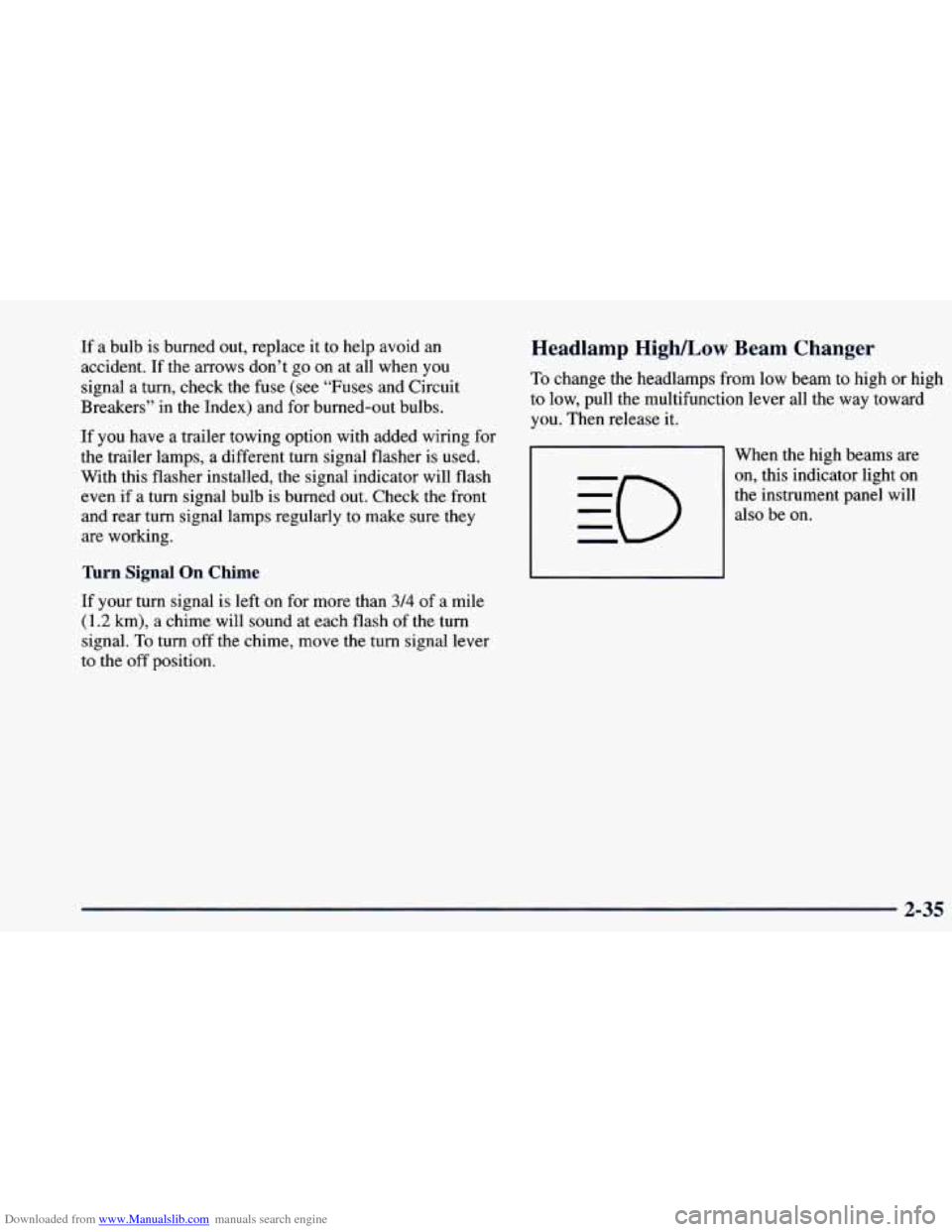
Downloaded from www.Manualslib.com manuals search engine If a bulb is burned out, replace it to help avoid an
accident. If the arrows don’t
go on at all when you
signal a turn, check the fuse (see “Fuses and Circuit
Breakers” in the Index) and for burned-out bulbs.
If
you have a trailer towing option with added wiring for
the trailer lamps, a different turn signal flasher is used.
With this flasher installed, the signal indicator will flash
even
if a turn signal bulb is burned out. Check the front
and rear turn signal lamps regularly to make sure they
are working.
-7 Signal On Chime
lr your turn signal is left on ror more than 3/4 of a mile
(1.2 km), a chime will sound at each flash of the turn
signal.
To turn off the chime, move the turn signal lever
to the off position.
Headlamp High/Low Beam Changer
To change the headlamps from low beam to high or high
to low, pull the multifunction lever all the way toward
you. Then release it.
When the high beams are on, this indicator light on
the instrument panel will
also be on.
2-35
Page 111 of 416
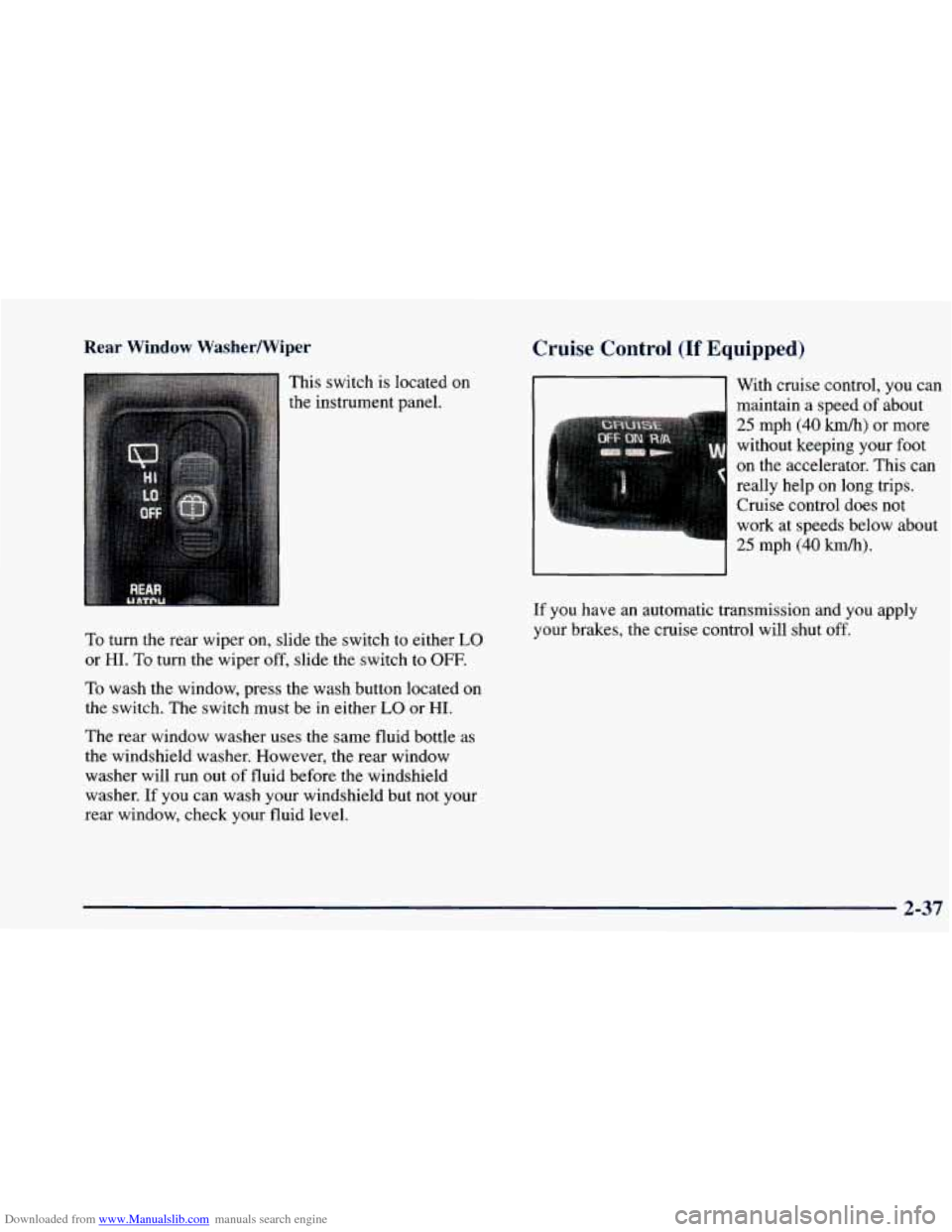
Downloaded from www.Manualslib.com manuals search engine Rear Window WasherWiper
To turn the rear wiper on, slide the switch to either LO
or HI. To turn the wiper off, slide the switch to OFF.
To wash the window, press the wash button located on
the switch. The switch must
be in either LO or HI.
The rear window washer uses the same fluid bottle as
the windshield washer. However, the rear window
washer will run out of fluid before the windshield
washer.
If you can wash your windshield but not your
rear window, check your fluid level.
Cruise Control (If Equipped)
11 With cruise control, you can
I maintain a speed of about
25 mph (40 km/h) or more
without keeping your foot
on the accelerator. This can
really help on long trips.
Cruise control does
not
work at speeds below about
If you have an automatic transmission and you apply
your brakes, the cruise control will shut
off.
2-37
Page 120 of 416
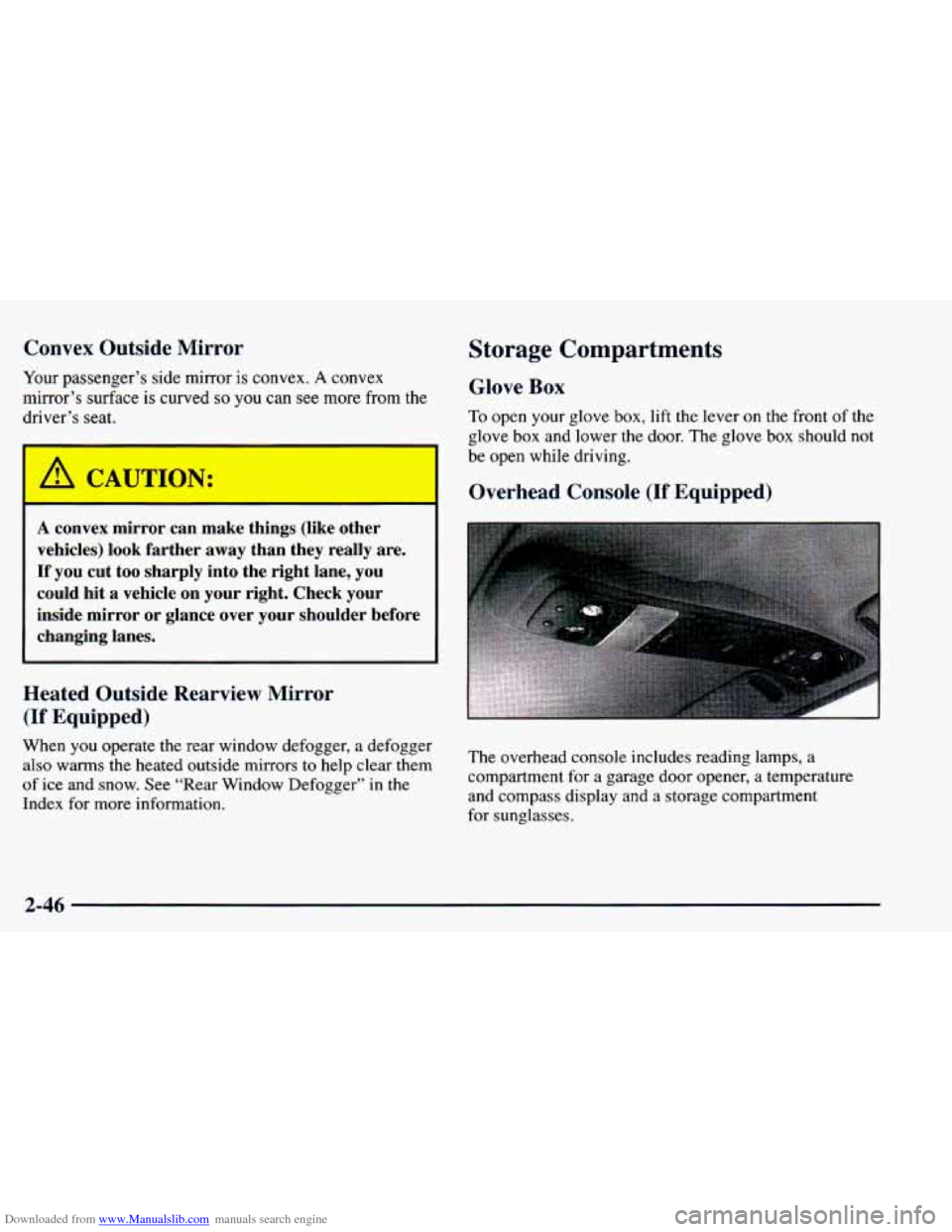
Downloaded from www.Manualslib.com manuals search engine Convex Outside Mirror
Your passenger’s side mirror is convex. A convex
mirror’s surface is curved so you can see more from the
driver’s seat.
Storage Compartments
Glove Box
To open your glove box, lift the lever on the front of the
glove
box and lower the door. The glove box should not
1 be open while driving.
4 Overhead Console (If Equipped)
A convex mirror can make things (like other
vehicles) look farther away than they really are.
If you cut too sharply into the right lane, you
could hit a vehicle on your right. Check your
inside mirror or glance over your shoulder before
changing lanes.
Heated Outside Rearview Mirror
(If Equipped)
When you operate the rear window defogger, a defogger also warms the heated outside mirrors to help clear them
of ice and snow. See “Rear Window Defogger’’ in
the
Index for more information. The overhead console includes reading lamps, a
compartment for a garage door opener, a temperature
and compass display and a storage compartment
for sunglasses.
2-46
Page 130 of 416
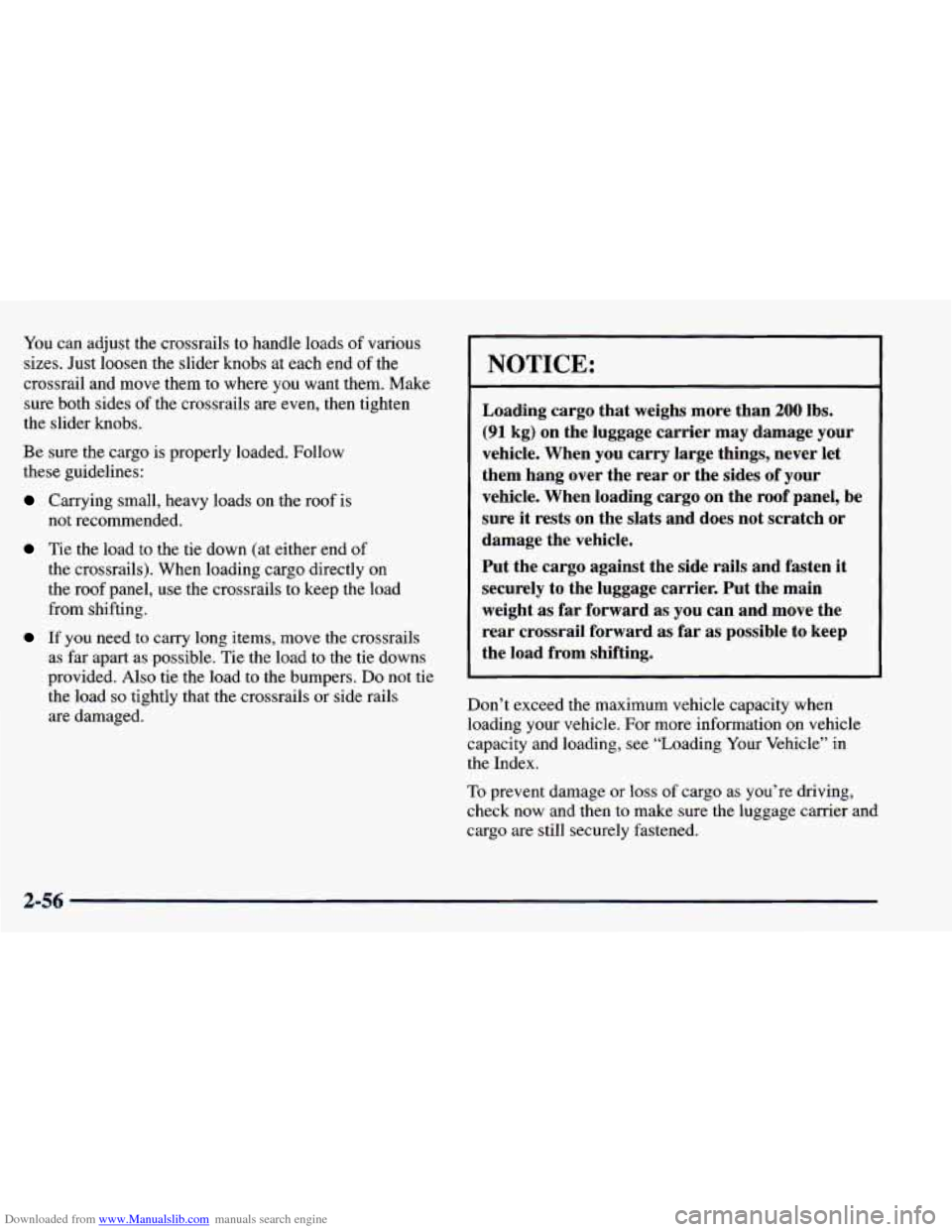
Downloaded from www.Manualslib.com manuals search engine rou can adjust the crossrails to handle loads of various
sizes. Just loosen
the slider knobs at each end of the
crossrail and
move them to where you want them. Make
sure both sides of the crossrails are even, then tighten
the slider knobs.
Be sure the cargo is properly loaded. Follow
these guidelines:
Carrying small, heavy loads on the roof is
not recommended.
Tie the load to the tie down (at either end of
the crossrails). When loading cargo directly on
the roof panel, use the crossrails to keep the load
from shifting.
If you need to carry long items, move the crossrails
as far apart as possible. Tie the load to the tie downs
provided.
Also tie the load to the bumpers. Do not tie
the load
so tightly that the crossrails or side rails
are damaged.
NOTICE:
Loading cargo that weighs more than 200 lbs.
(91 kg) on the luggage carrier may damage your
vehicle. When you carry large things, never let
them hang over the rear or the sides of your
vehicle. When loading cargo on the roof panel, be
sure it rests on the slats and does not scratch
or
damage the vehicle.
Put the cargo against the side rails and fasten it
securely to the luggage carrier. Put the main
weight
as far forward as you can and move the
rear crossrail forward as far as possible to keep
the load from shifting.
Don’t exceed the maximum vehicle capacity when loading your vehicle. For more information
on vehicle
capacity and loading, see “Loading
Your Vehicle” in
the Index.
To prevent damage or
loss of cargo as you’re driving,
check now and then to make sure the luggage carrier and
cargo are still securely fastened.
2-56
Page 142 of 416
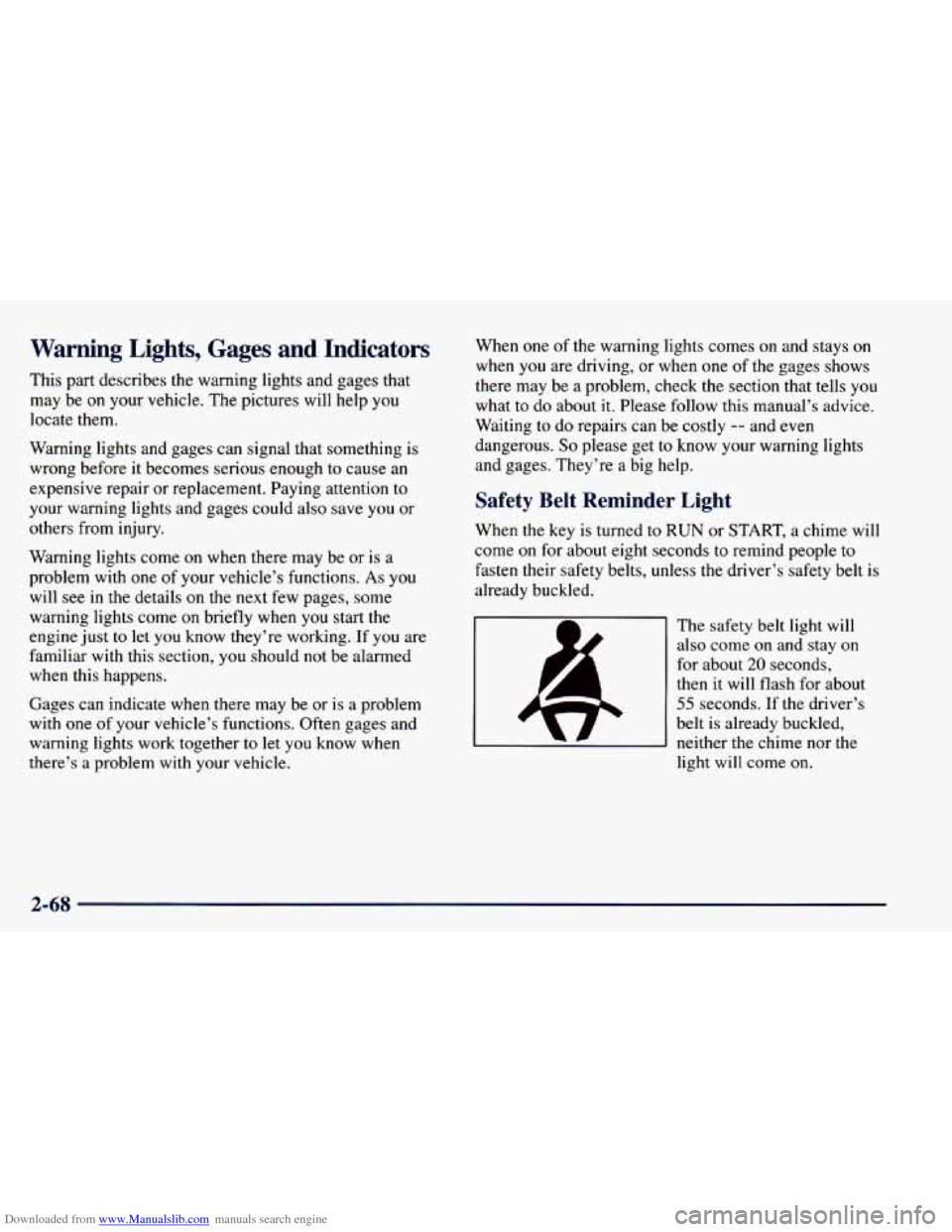
Downloaded from www.Manualslib.com manuals search engine Warning Lights, Gages and Indicators
This part describes the warning lights and gages that
may be
on your vehicle. The pictures will help you
locate them.
Warning lights and gages can signal that something is
wrong before it becomes serious enough to cause an
expensive repair or replacement. Paying attention to
your warning lights and gages
could also save you or
others from injury.
Warning lights come on when there may be or is a
problem with one
of your vehicle’s functions. As you
will see in the details on the next few pages, some
warning lights come on briefly when
you start the
engine just to let
you know they’re working. If you are
familiar with this section, you should not be alarmed
when this happens.
Gages can indicate when there may be or is a problem
with one of
your vehicle’s functions. Often gages and
warning lights work together to let
you know when
there’s a problem with your vehicle. When
one of the warning lights comes on and stays on
when you
are driving, or when one of the gages shows
there may be a problem, check the section that tells you
what to do about it. Please follow this manual’s advice.
Waiting
to do repairs can be costly -- and even
dangerous.
So please get to know your warning lights
and gages. They’re a big help.
Safety Belt Reminder Light
When the key is turned to RUN or START, a chime will
come
on for about eight seconds to remind people to
fasten their safety belts, unless the driver’s safety belt is
already buckled.
The safety belt light will
also come
on and stay on
for about
20 seconds,
then it will flash for about
55 seconds. If the driver’s
belt
is already buckled,
neither the chime nor the
light will come
on.
2-68
Page 143 of 416
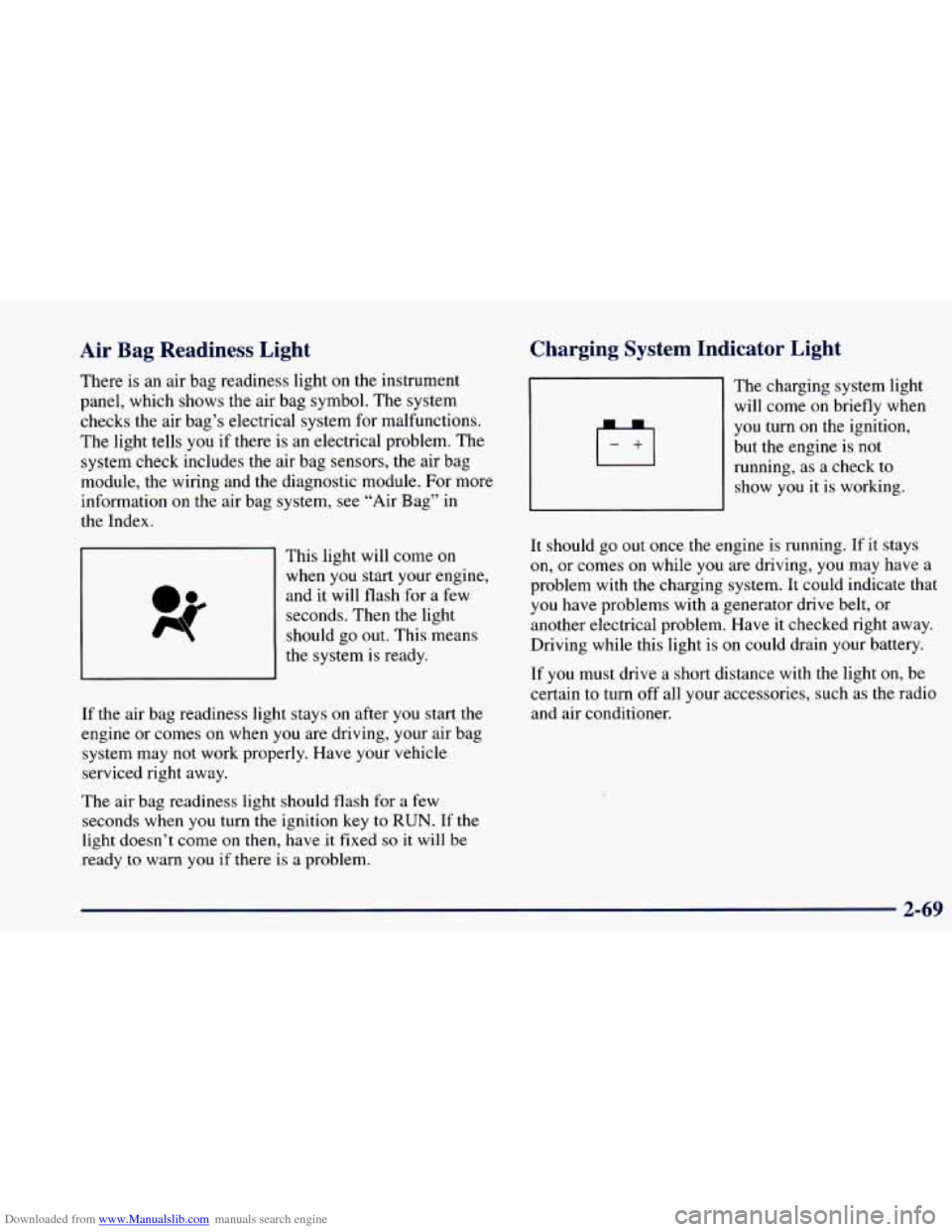
Downloaded from www.Manualslib.com manuals search engine Air Bag Readiness Light
There is an air bag readiness light on the instrument
panel, which shows the air bag symbol. The system
checks the air bag’s electrical system for malfunctions.
The light tells
you if there is an electrical problem. The
system check includes the air bag sensors, the air bag
module, the wiring and the diagnostic module. For more information on the air bag system, see “Air Bag” in
the Index.
This light will come
on
when you start your engine,
and it will flash for a few
seconds. Then the light
should go out. This means
the system is ready.
Charging System Indicator Light
If the air bag readiness light stays on after you start the
engine or comes on when
you are driving, your air bag
system may not work properly. Have your vehicle
serviced right away.
The air bag readiness light should flash for a few
seconds when
you turn the ignition key to RUN. If the
light doesn’t come on then, have it fixed
so it will be
ready to warn you if there is a problem. The
charging system light
will
come on briefly when
you turn on the ignition,
but the engine is not
running, as
a check to
show
you it is working.
It should go out once the engine is running.
If it stays
on, or comes on while
you are driving, you may have a
problem with the charging system. It could indicate that
you have problems with a generator drive belt, or
another electrical problem. Have it checked right away.
Driving while this light is
on could drain your battery.
If you must drive a short distance with the light on, be
certain to turn off all your accessories, such as the radio
and air conditioner.
2-69
Page 144 of 416
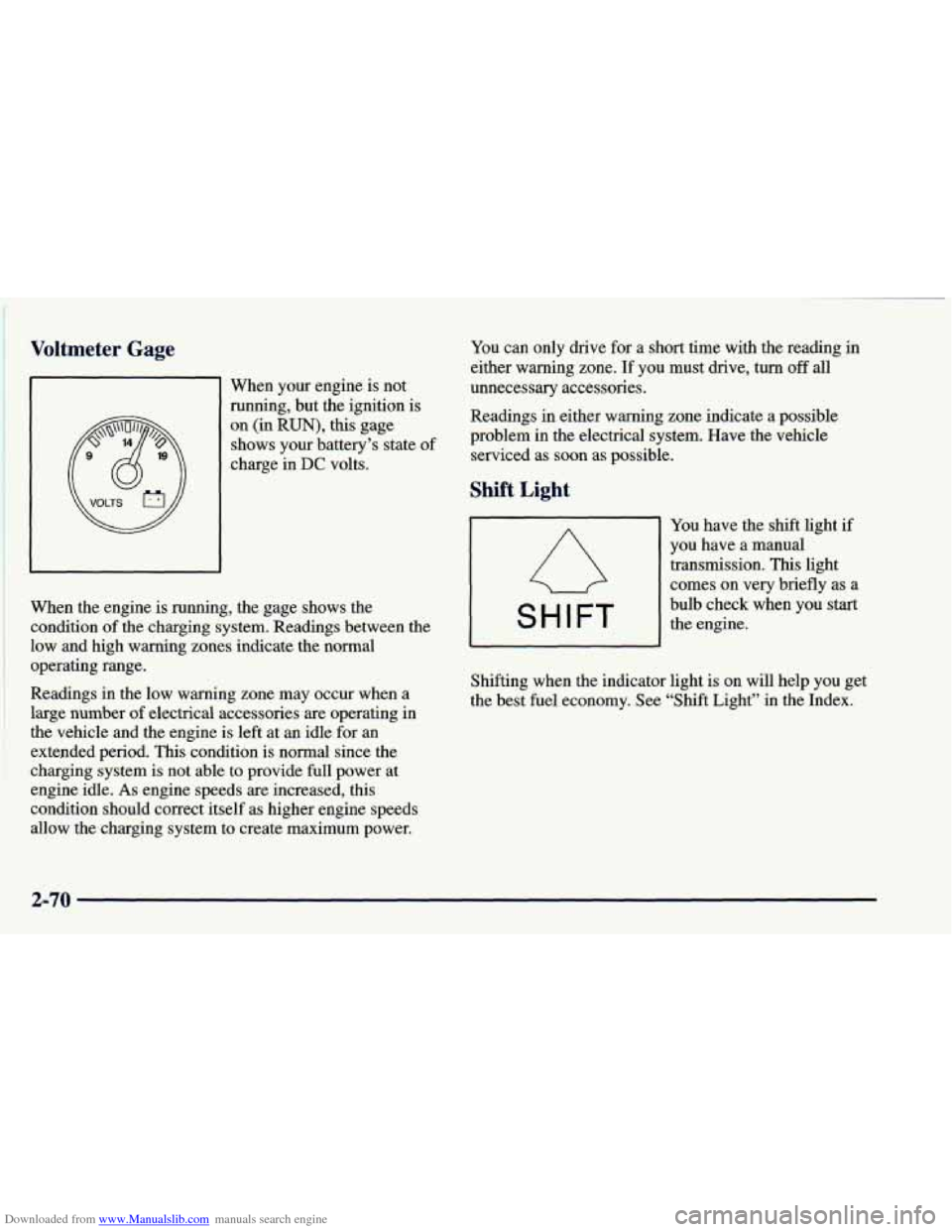
Downloaded from www.Manualslib.com manuals search engine Vo1’-- - - -* Gage
I When your engine is not
running, but the ignition is
on (in
RUN), this gage
shows your battery’s state of
charge in
DC volts.
When the engine
is running, the gage shows the
condition
of the charging system. Readings between the
low and high warning zones indicate the normal
operating range.
Readings in the low warning zone may occur when a
large number
of electrical accessories are operating in
the vehicle and the engine is left at an idle for
an
extended period. This condition is normal since the
charging system is not able to provide full power at
engine idle.
As engine speeds are increased, this
condition should correct itself as higher engine speeds
allow the charging system to create maximum power. You
can only drive for a short time with the reading in
either warning zone.
If you must drive, turn off all
unnecessary accessories.
Readings
in either warning zone indicate a possible
problem in the electrical system. Have the vehicle
serviced
as soon as possible.
Shift Light
You have the shift light if
you have a manual
transmission.
This light
comes on very briefly as a
SHIFT
bulb check when you start
the engine.
Shifting when the indicator light is on will help you get
the best fuel economy. See “Shift Light” in the Index.
2-70
Page 147 of 416
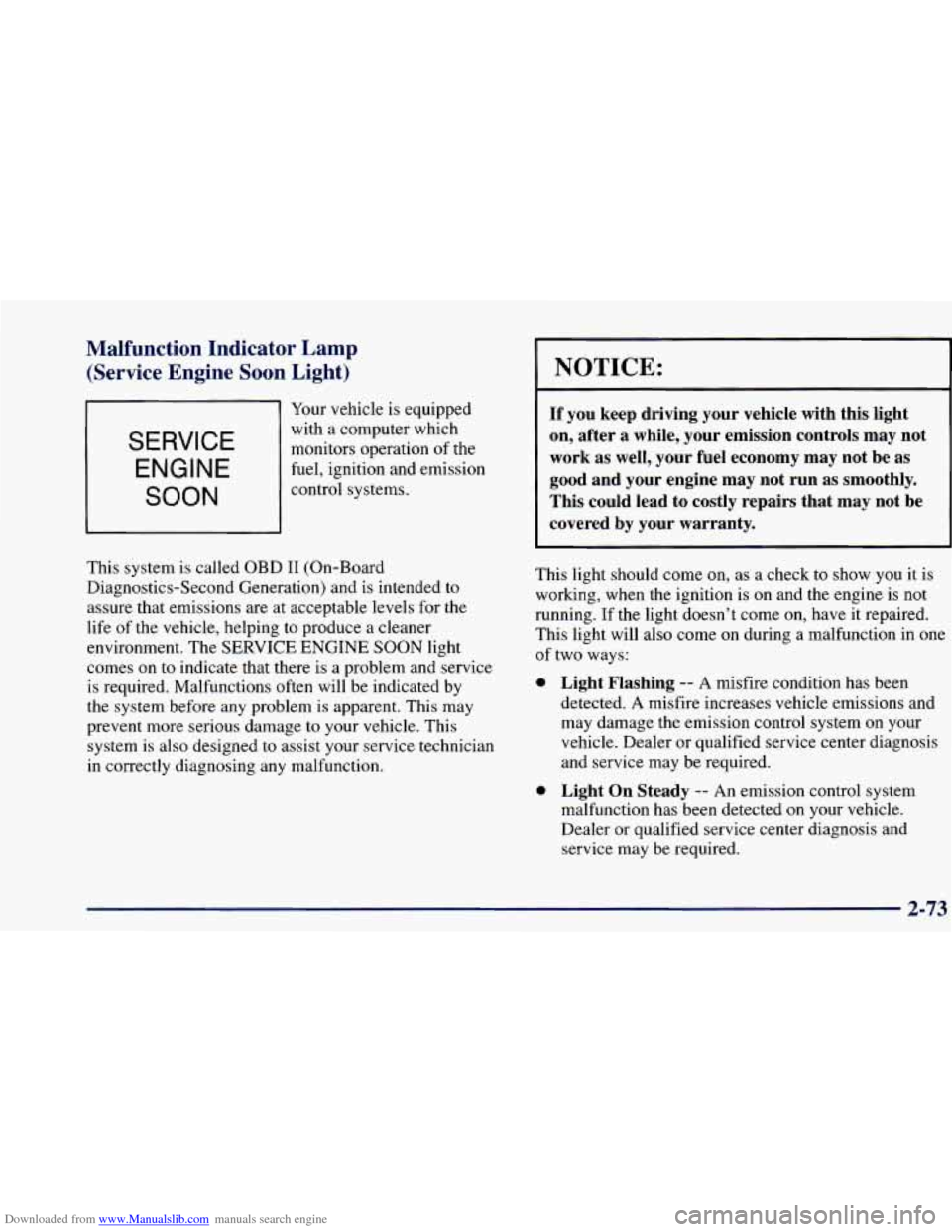
Downloaded from www.Manualslib.com manuals search engine Malfunction Indicator Lamp (Service Engir light)
SERVICE
ENGINE
SOON
Your vehicle is equipped
with a computer which
monitors operation
of the
fuel, ignition and emission
control systems.
This system is called OBD I1 (On-Board
Diagnostics-Second Generation) and is intended to
assure that emissions are at acceptable levels for the
life of the vehicle, helping to produce a cleaner
environment. The
SERVICE ENGINE SOON light
comes on
to indicate that there is a problem and service
is required. Malfunctions often will be indicated by
the system before any problem
is apparent. This may
prevent more serious damage to your vehicle. This
system is also designed to assist your service technician
in correctly diagnosing any malfunction.
NOTICE:
If you keep driving your vehicle with this light
on, after a while, your emission controls may not
work as well, your fuel economy may not be as
good and your engine may not run as smoothly.
This could lead to costly repairs that may not be
covered by your warranty.
This light should come on, as a check to show you it is
working, when the ignition is
on and the engine is not
running. If the light doesn’t come on, have it repaired.
This light will also come
on during a malfunction in one
of two ways:
0
0
Light Flashing -- A misfire condition has been
detected.
A misfire increases vehicle emissions and
may damage the emission control system
on your
vehicle. Dealer
or qualified service center diagnosis
and service may be required.
Light On Steady -- An emission control system
malfunction has been detected on your vehicle.
Dealer or qualified service center diagnosis and service may be required.
2-73
Page 149 of 416
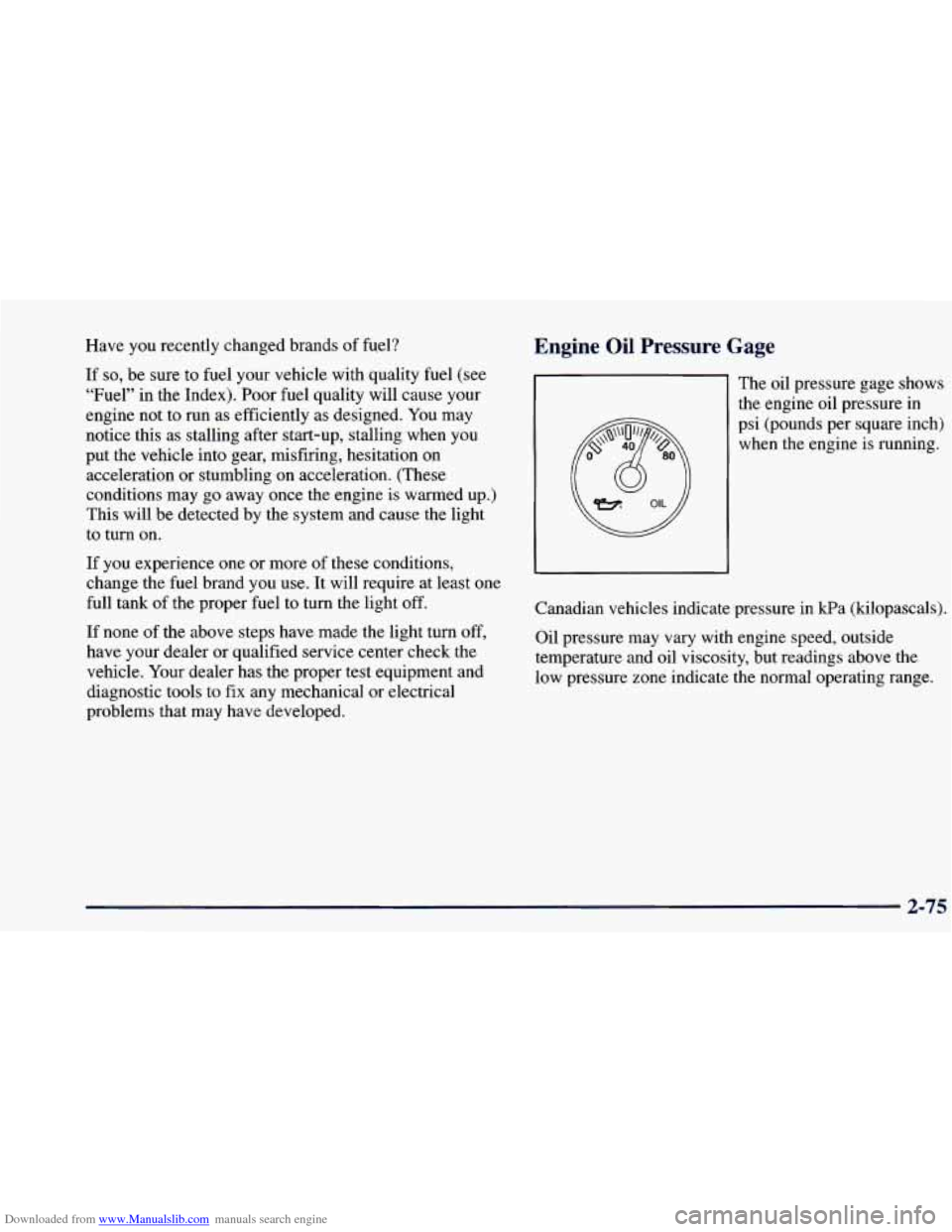
Downloaded from www.Manualslib.com manuals search engine Have you recently changed brands of fu.el?
If so, be sure to fuel your vehicle with quality fuel (see
“Fuel” in the Index). Poor fuel quality will cause your
engine not to run as efficiently as designed. You may
notice this as stalling after start-up, stalling when you
put the vehicle into gear, misfiring, hesitation on
acceleration or stumbling on acceleration. (These
conditions may go away once the engine is warmed up.)
This will be detected by the system and cause the light
to turn on.
If you experience one or more of these conditions,
change the fuel brand you use. It will require at least one
full tank of the proper fuel to turn the light off.
If none of the above steps have made the light
turn off,
have your dealer or qualified service center check the
vehicle. Your dealer has the proper test equipment and
diagnostic tools to fix
any mechanical or electrical
problems that may have developed.
Engine Oil Pressure Gage
The oil pressure gage shows
the engine oil pressure in
psi (pounds per square inch)
when the engine is running.
Canadian vehicles indicate pressure in kPa (kilopascals).
Oil pressure may vary with engine speed, outside
temperature and oil viscosity, but readings above the
low pressure zone indicate the normal operating range.
2-75
Page 150 of 416
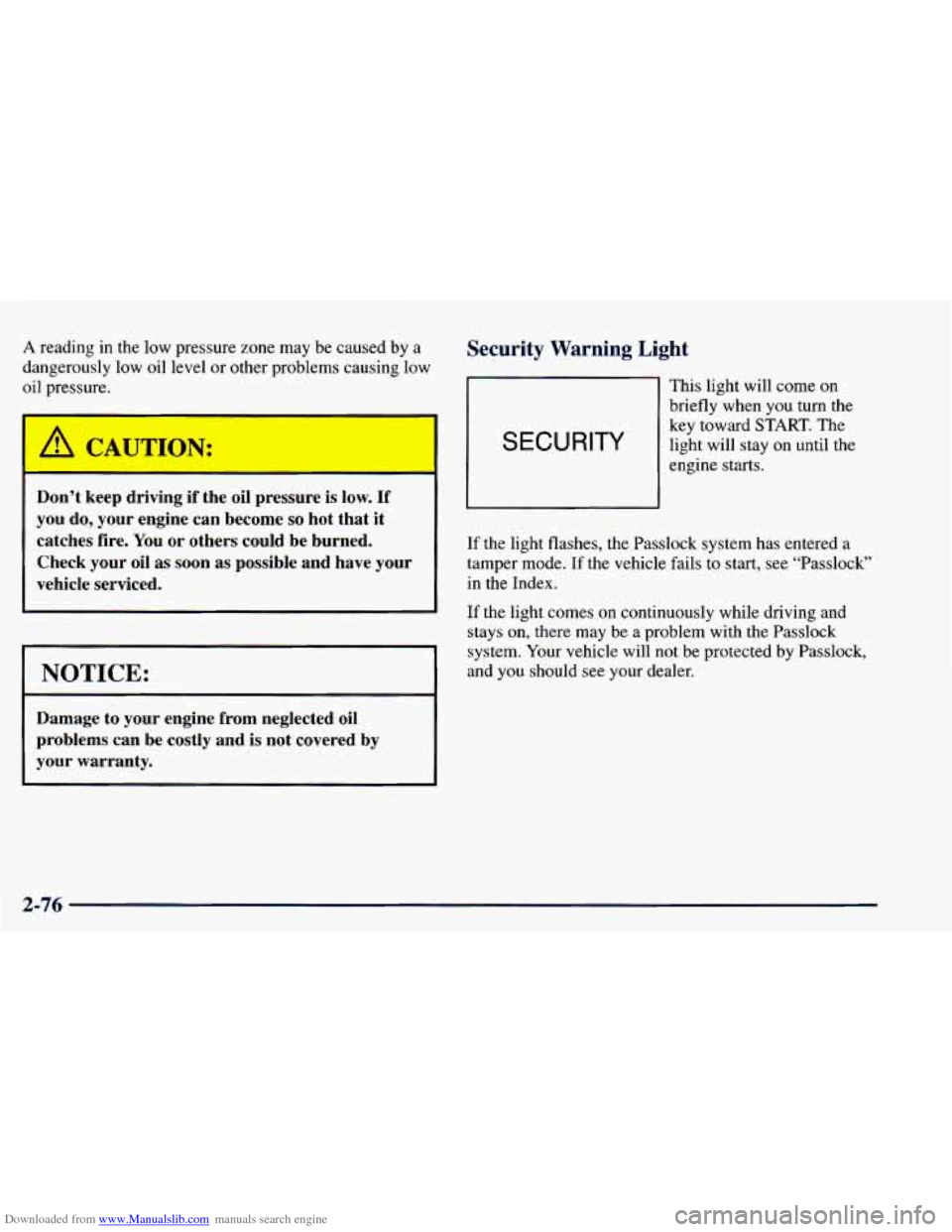
Downloaded from www.Manualslib.com manuals search engine A reading in the low pressure zone may be caused by a
dangerously low oil level or other problems causing low
oil pressure.
Don’t keep driving
if the oil pressure is low. If
you do, your engine can become so hot that it
catches fire.
You or others could be burned.
Check your oil
as soon as possible and have your
vehicle serviced.
I NOTICE:
Security Warning Light
Damage to your engine from neglected oil
problems can be costly and is not covered by
your warranty.
SECURITY
This light will come on
briefly when
you turn the
key toward START. The
light will stay
on until the
engine starts.
If the light flashes, the Passlock
system has entered a
tamper mode. If the vehicle fails
to start, see “Passlock”
in the Index.
If the light comes on continuously while driving and
stays
on, there may be a problem with the Passlock
system. Your vehicle will not be protected bv Passlock,
and you should see your dealer.
2-76